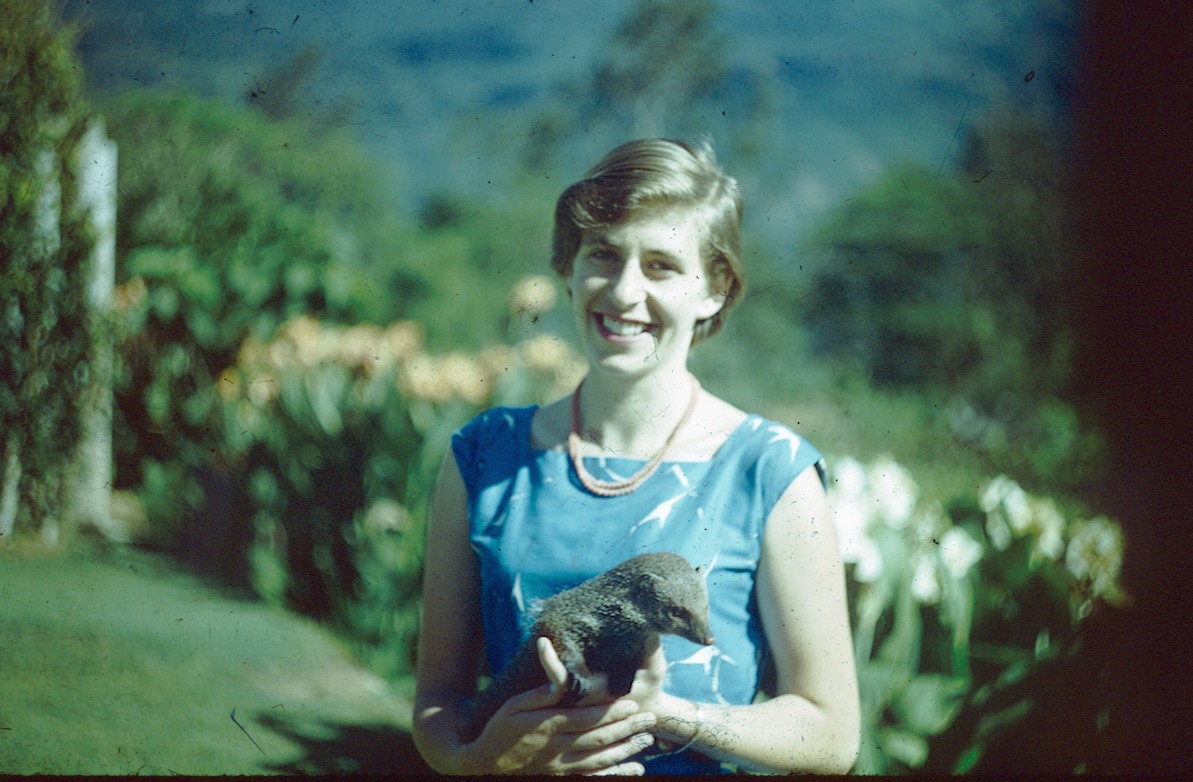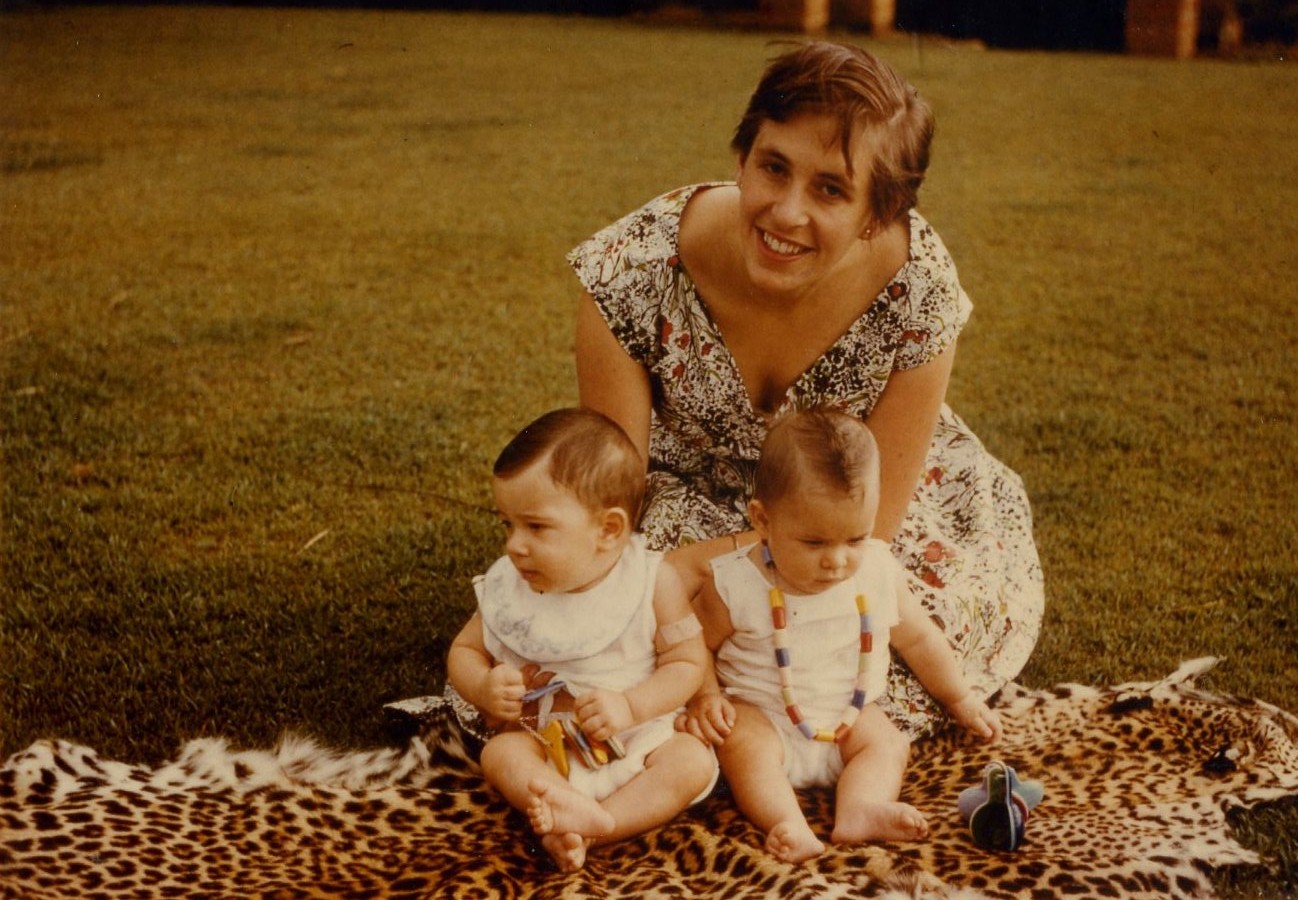about 1,000 ft. The mud slide continued for about 2 months with tea bushes, and huge boulders etc slowly sliding to the edge and then cascading down. As it fell the mud avalanche divided into two and passed on either side of a small knoll on which was built a Hindu temple. The Tamils were most impressed how their temple although inaccessible at the time was quite unscathed. This they believed was due to God’s favour on them all and they were very thankful! As the monsoon lifted in February we could once again put the twins out under the flame tree. They were now coming on well and crawling everywhere and Jill would keep the closest eye on them all the time to do everything correctly. At nine months when they could sit up well she started potty training and they would look sweet each tied with a nappy around its waist to the foot of the cot to stop them careering around the nursery. At a year old Peter was just about starting to walk. The Estate carpenter made a wooden trolley with wooden wheels and he would push this around the lawn with great strength. Janet was a bit behind in physical strength but a couple of months later she too was able to do the same thing. Jill was always now either up at Gampaha with her friend Penny and swimming in their lovely pool or with Susan Fincher who had now adopted a little girl called Mary. So at home we were a self contained unit with the family, our chickens, cows, and pigs which I would slaughter with a .22 rifle bullet placed through its temple. The animal would be cleaned by the servants, and appropriately cut into suitable portions and frozen. The legs Jill would cure in a bath of saltpetre injecting extra near the bone with a hypodermic syringe. After some weeks the legs would be smoked all day by being suspended from a rope hanging under the bouganvillea arch into a metal barrel with both ends cut out. Sawdust from the estate carpenter would be lit and allowed to smoulder below the barrel and whether or not it was the eucalyptus, grevillea or jak wood that was used, the hams made were superb. Likewise she kept chickens the cockerels which she would caponise with a stilbestrol pellet injected into its neck. Jill was always wonderfully practical and adaptable to new problems and was forever puzzling how to be more self sufficient and always learning some new trick or from other wives. She was a real toughie adaptable type and the more I saw the more and greater my admiration for her grew. Far rather than moan like some others she would always try and find a way around a problem, and so we had a wonderful happy and contented home. With our Sinhalese gardener Wilbert we had a good vegetable garden, and I grew the most wonderful mushrooms on goat manure and lime in our mud brick chicken houses. So prolific did they grow that they would be sprouting out of the walls 3 or 4 ft off the ground! In the garden I continued with my father’s orchids and grew excellent roses which were a bit ‘leggy’ due to the heat. Also in the garden I planted all sorts of exotic trees such as an amherstia, browneas and tabebuas from Venezuela jacarandas etc. On the estate to beautify it and give a nice scent, I had planted dozens of lemon scented eucalyptus gums which after a shower of rain would give off the most glorious aroma and most are still there to this day.
But storm clouds were starting slowly at first to cloud this idyll. In 1957 for the first time since I had started work, local politics started to affect the running of the Estate with an instability that seven years later would cause us to have to leave our lovely Ceylon. Until 1956 in the post independence period, the country had been run by the United National Party a conservative body under the benign leadership of Dudley Sennanayake and Oliver Goonetilike , with changes being only slowly adopted. Great efforts were made in the re-colonising the low country jungles and in starting major irrigation schemes by the building of modern dams. But the Buddhist priests and Sinhalese traditionalists dismissed the party dressed in their Western business suits, as little more than “Brown Englishmen”. In the 1956 elections they found a leader far more sympathetic to their aspirations in Mr S.W.R.D.Bandaranaike. He was a nobleman from one one the great Sinhalese Low Country Families, highly intelligent and extremely well read. He was very much an educated 1930’s “Bloomsbury set type”, and had studied at Oxford where he became the President of the Oxford Union. Like Nehru of India, a close friend, he had then gone on to the London School of Economics where he had again excelled under its brilliant socialist head Harold Laski one of the mentors of the Labour Party. Unfortunately the Socialism of Laski proved to be a disaster economically, not only for a wealthy country like Britain, but in India and Ceylon with large populations steeped in poverty, all commercial activity was burdened by controls and was to grind slowly to a standstill due to a vast web of bureaucracy, restrictions and the natural tendency of the Indian for introducing permits and red tape which in turn led to an increase in bribery and endless litigation which of course lawyers love, but dampens wealth generation. Bandaranaike was married to Sirima Ratwatte an ambitious and very politically astute lady from the leading Kandyan Hill family. She too at that time was very socialistically inclined, and both believed implicitly that their course was the correct one that was set on the wave of the future. Instead of Western suits, both dressed in traditional local costume, he always in all white muslin tunic and collarless shirt with scarf. They toured the interior of the country promising the villagers, the schoolmasters and the small shopkeepers, that their interests which they felt had been forgotten by the western elite of Colombo, would in future be paramount. They won a resounding election victory in 1956 which initially did not cause us much concern. My father would always re-iterate:
“ They can elect who they wish but in the end they can never kill the goose that lays the golden eggs which is the plantation industry of tea and rubber”.
Once elected Bandaranaike increasingly pandered to the Sinhalese xenophobes with an ultra nationalist policy of making Sinhalese the sole national Language a move that would at a stroke isolate the Tamils, the Dutch Burghers who all had progressed to the top echelons of the Civil Service and the major professions by passing competitive exams in English. The Jaffna, Trincomalee and Batticaloe Tamils who comprised about 20% of the population particularly felt very aggrieved. They were a hard working, highly intelligent rather dour people from an arid environment, that had through the setting up of good schools in their areas under the British, come to dominate the higher professions. They had combined with the Sinhalese to demand Independance from the British, and now they felt betrayed by an intellectual who was trying to marginalise their ambitions , through playing cheap racial politics in order to curry votes from the majority population. Small pinpricks like the new number plates for cars were now made in the Sinhalese pali script instead of roman letters causing riots started by extremists. The natural harmony of the races was disrupted and everywhere extremists were now gathering around themselves new power bases and battallions to have battle with others from a different community or social group. The racial genie that Bandaranaike uncorked from the sealed bottle was first to lead to his own assassination by men even more fanatical than he, and then over the next half century to dominate all politics in the island, and would eventually lead to a most merciless and intractable war between the communities which still goes on to this day.




